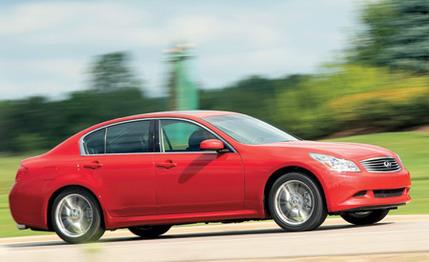
 Road Test
Road Test
It's no secret that creating a new car whose visual and visceral appeals hit enough buyer sweet spots to make it a winner is chapter one in the great book of designer challenges. Not so well known, though, is chapter two: the follow-up. When the debutante gets rave reviews, whaddya do for the encore in four years? A major makeover? Or just the automotive equivalent of a little more eye shadow and a few sequins.
BMW has faced this challenge with its 3-series sedans for decades, responding each time with a cautious evolutionary styling update augmented by significant engineering improvements. It's an approach that obviously works - for BMW. The 3-series is the benchmark in the entry luxury-sports-sedan segment, with 15 consecutive appearances on the Car and Driver 10Best Cars list to underscore its preeminence.
But can this policy work for a newcomer? Has the second-gen G35 got the chops to keep pace with the fifth-gen Bimmer? The short answer is a definite maybe.
History: The G35 was an unknown quantity when it made its appearance in mid-2002 as an '03 model - an eager rear-drive sports sedan replacing the I35, a badge-job version of the front-drive Nissan Maxima. Suddenly, Infiniti was a real contender in a game that has belonged almost exclusively to players from Germany, particularly those hailing from Bavaria. The real exclamation point came when a G35 prevailed in a seven-car sports-sedan shootout that included - ta-da! - a BMW ["$35,000 Sports Sedans," C/D, March 2004]. Okay, the deck was stacked slightly in the G35's favor. To keep the playing field level by price, the BMW was a 325i rather than a 330i, thus giving away 76 horses to its Asian assailant. But never mind. How many other Japanese sedans have topped a BMW 3-series sedan in C/D comparos over the past 20 years? Clue: zero.
The 3-series reasserted its primacy in a "$35,000 Sports Sedans" rematch that included a 2006 Lexus IS350 [ C/D, October 2005], and we described the G35 as "aging gracefully." How quickly new becomes not-so-new in the car biz. But more to the point, we think it likely the updated G would have given the 330i a much stronger run for first place. Here's why.
Leaving the cautious styling update aside for the moment, this is a distinctly more capable G35 than the original: quicker straight ahead, quicker on its feet, with a new variable-assist rack-and-pinion steering system that tells the driver more about what the front tires are doing than did the previous setup. Infiniti also offers a new active-steering option that's touted as a response enhancer, but it wasn't present on our test car, and in any case, we wonder whether it's worth the extra money - $1200, at a guess - or the added weight - about 25 pounds.
Speaking of weight, like almost all new cars, the G35 scales in a little heavier than the previous edition. Infiniti says 48 pounds and lists curb weight at 3532. In our comparo a year ago, the G35 weighed 3520, and this similarly equipped '07 version ran our needle up to 3583. Increased mass is never a good thing - you probably notice that when you step on the scales at home - but in this case there are mitigating factors. For one, the updated FM architecture, shared with the Nissan 350Z and Infiniti FX45, is 40 percent stiffer, according to Infiniti, due in part to more extensive spot and seam welding in the unibody.
For another, there's more thrust from the car's 3.5-liter V-6 engine, the fourth generation of Nissan's VQ series. Although the bore and stroke specs of this oversquare design are unchanged, Nissan says the engine is 80 percent new, with a beefier bottom end, variable cam timing on the intake and exhaust valves (the previous engine was intake side only), reduced exhaust back pressure, a slightly higher compression ratio (10.6:1 versus 10.3), a higher redline (7600 rpm versus 7000), and improved coolant flow - among other tweaks. It all adds up to 306 horsepower at 6800 rpm and 268 pound-feet of torque at 5200 rpm.
The previous engine carried a 2006 rating of 298 horsepower and 260 pound-feet, so at a glance, this doesn't look like much of an increase, particularly with a corresponding gain at the scales. However, the old power numbers were published before the Society of Automotive Engineers instituted its new and more stringent rating system, which means the output disparity between old and new is actually bigger. In addition, Nissan notes that the new engine's breathing is enhanced by a ram effect through the dual air-intake system, to the tune of three more ponies at 60 mph.
Nissan calls this effect, and the car's all-around acceleration characteristics, "swell," in the sense of a wave gathering power as it moves along. Uh-huh. We took our test car to the track, where it hunkered down and dashed to 60 mph in 5.2 seconds, covering the quarter-mile in 13.9 seconds at 103. Hmm, that is swell, and considerably quicker than the last G35 we tested (0 to 60 in 5.9 seconds and the quarter in 14.6 at 98 mph) as well as just a blink behind the IS350. More impressive still, our G35 tester went to the track with fewer than 250 miles on the odo. That's like putting an Olympic sprinter in the starting blocks in his street clothes. What'll it do with a proper break-in? We look forward to finding out.
The power feeds through a six-speed manual gearbox that's the personification of precise engagement - it makes BMW's 3-series manual transmissions seem rubbery - to a limited-slip rear end and thence to the pavement via a set of 245/45-18 Bridgestone Potenza RE050A tires.